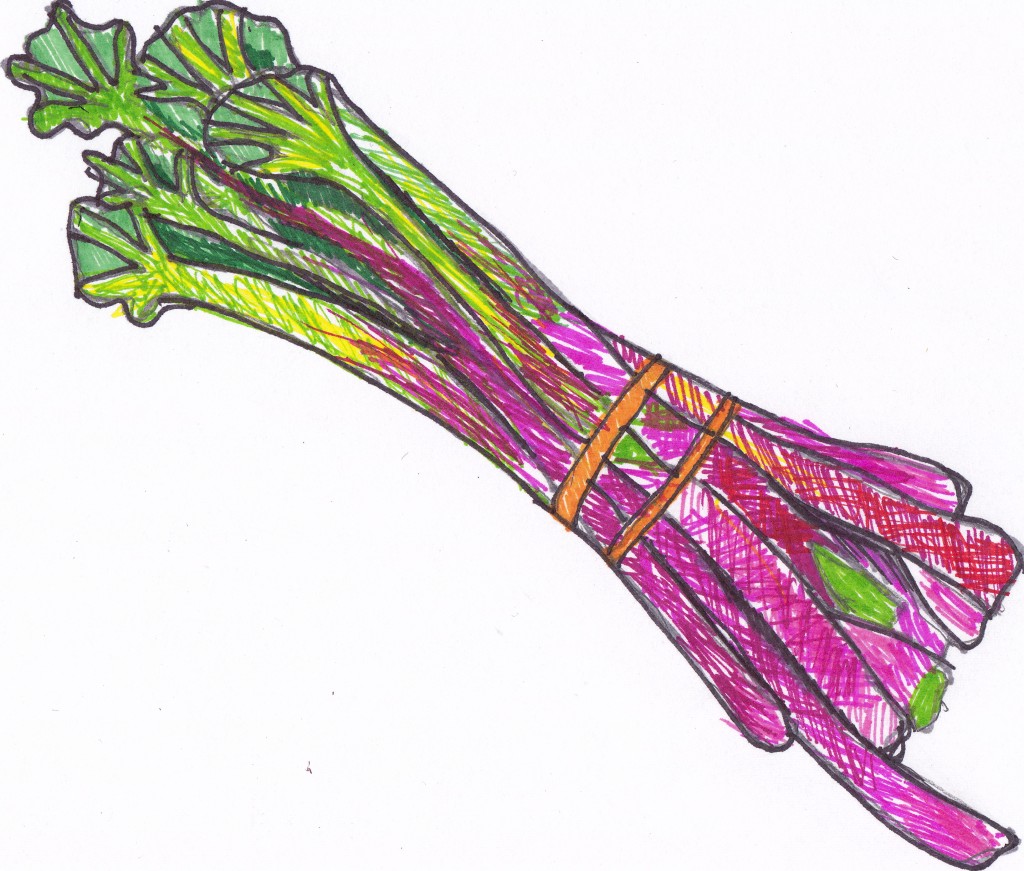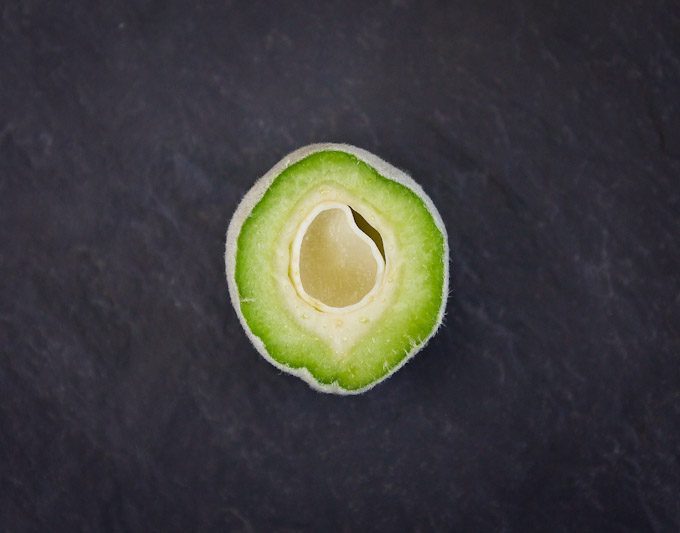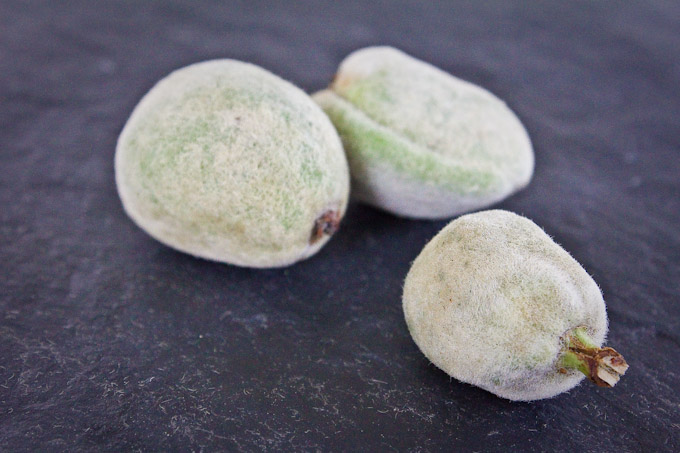I love rhubarb. I love it for it's old fashioned vibe. I love it for it's color, striking tartness, and even for it's moderate shelf life. I also love it for showing up so darn early in the spring and sticking around for several months. And I too was at first intimidated by those long, irregular-shaped, tough magenta stalks at the market. I actually overheard a conversation at our market up here recently, where a woman who had just bought a weekend house near the Delaware discovered she had huge decades-old rhubarb plants growing on her property. However she didn't know when it was time to pick them. Nor did the young woman working the farm stand, so I jumped in with what I knew. She had been waiting for them to turn red, ripen, to pick. I explained that some heirloom varieties, have very little red, and the stalks can range from thin to the thicker more uniform we're used to seeing in grocery stores. I generally go by feel, but you can harvest stalks when between ten and fifteen inches long, avoiding letting them go too long and become tough, dry or woody. Once you get your rhubarb back you your kitchen, from yard or market, they really are one of the most simple fruit to prepare. Make sure all traces of the leaves are trimmed off, as they are not edible. Rhubarb have a bad rap for being stringy, as in celery stringy, but as long as they are cut in small pieces before cooked, the strings will not be a nuisance. For good measure, or habit, I tend to peel two or three strings off each stalk, from end to end, but not too much, as you are also peeling off any of the great magenta color. Wash the stalks well and then cut into slices between an half inch and an inch thick. You can then roast the pieces, throw them in to brighten up a rich stew, or as I do most often, simmer them down to a quick rhubarb puree or sauce. Pack the rhubarb into a sauce pan or small pot that holds the pieces sort of snugly. Add enough water to come up about 3/4 of the way up the sides of the slices, and simmer over a medium-low heat, until the rhubarb has broken down and is tender. Add more water if the mixture seems to be getting to dry or risking burning at all. When finished you can mash it up a little to have a sauce with more texture, or use a food processor, blender or immersion blender to give you smoother final product. If you are looking to use the sauce as a topping by itself, add about a tablespoon of sugar per large stalk of rhubarb when simmering down, or another classic way to cut rhubarb's intense sourness is to add at least 1 part strawberries for every 3 parts rhubarb when starting the sauce. Taste when finished and adjust sweetness if necessary. Vanilla beans, ginger, orange, cinnamon, almost all berries and apples are all great additions as well. Make a big batch. Eat it warm or ice cold. Spoon it over ice cream, blend it into cream cheese, swirl it in yogurt or oatmeal, drizzle it over a wedge of Stilton or duck or game meats, whisk it into your vinaigrette, blend it with ice for your margarita. Really, what other fruit, the northeast no less, is quite so versatile? | ||||||||||||||||
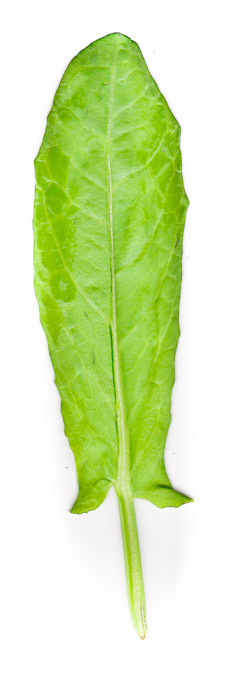 Sorrel (and its many varieties and names: garden sorrel, english sorrel, common sorrel, french sorrel) is showing up now in abundance at farmers markets and in gardens. It is a perennial (it comes back each year) herb, with super tender leaves that pack a ton of vitamins C and A. Sorrel (and its many varieties and names: garden sorrel, english sorrel, common sorrel, french sorrel) is showing up now in abundance at farmers markets and in gardens. It is a perennial (it comes back each year) herb, with super tender leaves that pack a ton of vitamins C and A.It is incredibly easy to grow yourself, in a spot with full sun. We planted a small plant last year, basically ignored it, and this season it has not only returned, but is already 2+ feet tall. The long, oval, slightly pointed, arrow-like leaves are thin, soft and delicate, like a baby lettuce leaf. What is most remarkable about this herb is its decidedly sour flavor. The name Sorrel is derived from the word sour, and is also, with a deliberate nod, the name of the sour-lipped daughter in Noel Coward's Hay Fever. A role I've played and adored. Bright and tart, it is not unlike adding lemon zest to a recipe. The flavor mellows out a good amount when cooked, and is less pronounced in younger leaves. But to get it's full get its full zing, it can definitely be used raw. Sorrel is wonderful added to salads, or pureed raw and frozen to brighten up winter dishes. It is a natural with eggs, potatoes, fish, or pureed in a cream sauce, and can be sauteed like spinach. My first experience cooking with sorrel, and still my favorite, is a Chard and Sorrel Soup found in Deborah Madison's vegetable-bible cookbook Vegetarian Cooking for Everyone Keep an eye out for this leafy green treasure at markets now and throughout the summer. Buy more than you need, and freeze some for when your heavy root vegetable winter month meals need some summery assistance. | ||||||||||||||||
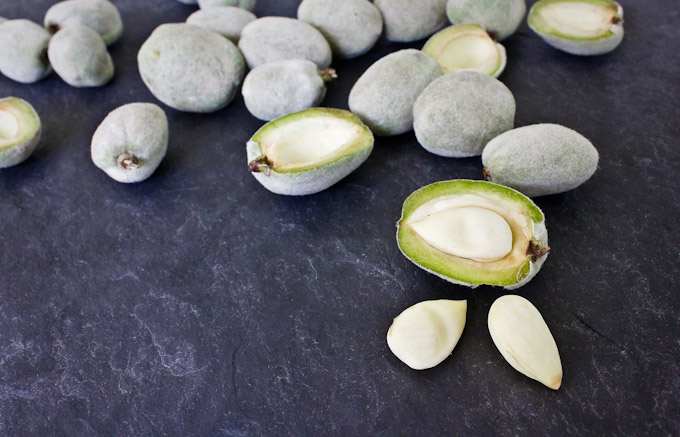 Recently I was in the Batali/Bastianich Italian food megastore Eataly in NYC. Always a recipe-provoking stop, particularly mid-week when not utterly tourist-jammed and you can actually see the counters and food. The variety of food and ingredient offerings is as impressive as the block-wide size of this culinary cathedral. Rarely do I go there and not see something I have never encountered previously. Never have I been able to leave there empty handed. 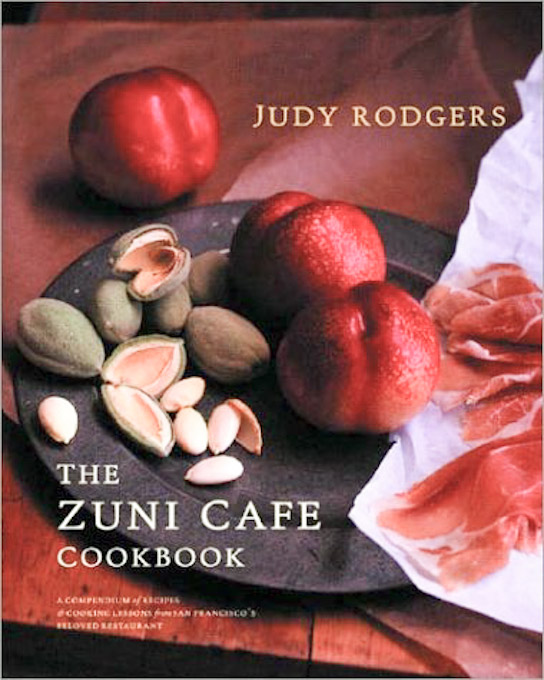 On this balmy day I came across a long basket of fuzzy green almonds. The only other time I've seen them was on the cover of my beloved Zuni Cafe cookbook On this balmy day I came across a long basket of fuzzy green almonds. The only other time I've seen them was on the cover of my beloved Zuni Cafe cookbookSo into my basket went a half pound. After a little investigating, I learned that these green almonds were the unripe fruit of the almond tree, and while green, the outer flesh, and in turn entire fruit, is edible. The green-fuzzy flesh is firm and crisp, much like biting into an unripe peach--of which they are a relative and bear a striking resemblance in this form. The inside almond nut, with which we are much more familiar, was still pale white, soft and jelly-like on the inside. Biting into that was like a sliver of a firm grape, with just the slightest burst of moisture. None of the flavors are particularly strong, but just fresh and green and vital. The outside flesh tastes much like a cross between an unripe peach and a fresh-picked raw green bean. The center jellied nut was slightly sweeter with just a hint of sour, but again, nothing overpowering. But the combination of textures and herbaceous qualities I found thrilling and unable to put down. Green almonds are popular in many Middle Eastern cuisines, simply dipped lightly in a dish of salt as they are eaten. This way was my favorite. Like many of their green baby spring cohorts, these green almonds are only available for a brief eight week season from mid-April to mid-June. I was a little late to the party too this year, but keep your eyes out this week and definitely snap some up if you come across them. Put them on your radar for next year regardless. | ||||||||||||||||
|
|
{ welcome! }
 Catie Baumer Schwalb is a chef, food writer and photographer, who splits her life between the city and the country. Not too long ago Catie was a New York City based actress and playwright for more than a decade. She has her Master of Fine Arts from the National Theater Conservatory, and her Grand Diplôme in classic culinary arts from the French Culinary Institute in New York City.
... Read More ≫
Catie Baumer Schwalb is a chef, food writer and photographer, who splits her life between the city and the country. Not too long ago Catie was a New York City based actress and playwright for more than a decade. She has her Master of Fine Arts from the National Theater Conservatory, and her Grand Diplôme in classic culinary arts from the French Culinary Institute in New York City.
... Read More ≫{ get in touch }
{ what's new }
September 12, 2015
August 19, 2013
August 15, 2013
August 13, 2013
August 1, 2013
{ favorites }
{ archives }
Appetizers / Breads & Pastry / Breakfast / Cakes / Canning / Condiments / Dinner / DIY foods / Drinks / Fall / favorites / Grains / Holidays / Local / Noodles & Pasta / Pies & Tarts / Poultry / Salads / Seafood / Snacks / Soup / Spring / Summer / Sweets / Techniques / Vegetables / Vegetarian / Winter /
{ currently reading }
|



